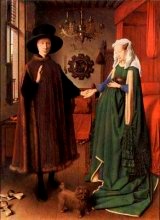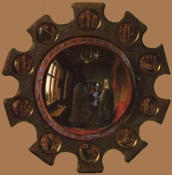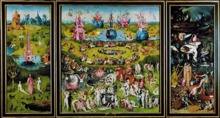
Here are two paintings particularly famous for the symbols included in them:

Jan van Eyck (Dutch, died 1441), The Arnolfini Marriage [The Betrothal of Giovanni Arnolfini and Giovanna Cenami], 1434, oil
 on wood panel, 81.8 x 59.7 cm, National Gallery, London. The bride to be has placed her right hand into the left hand of her fiancé to symbolize their intention to wed. Some of the other symbols: a dog symbolizes love and fidelity, a pair of white slippers in the lower left symbolize the sanctity of marriage, fruits on the windowsill symbolize fertility and original sin, a candle burning in daylight acknowledges faith in God as well as his all-seeing eye.
on wood panel, 81.8 x 59.7 cm, National Gallery, London. The bride to be has placed her right hand into the left hand of her fiancé to symbolize their intention to wed. Some of the other symbols: a dog symbolizes love and fidelity, a pair of white slippers in the lower left symbolize the sanctity of marriage, fruits on the windowsill symbolize fertility and original sin, a candle burning in daylight acknowledges faith in God as well as his all-seeing eye. A convex mirror hangs on the wall behind the bride and groom. In this mirror is a reflection of the backs of the principal figures, accompanied by those of the painter and another man who witness the betrothal. The frame of the mirror contains ten medallions portraying scenes from the life of Christ. See convex, Dutch art, frame, and mirror.

Hieronymus [Jerome] Bosch (Dutch, 1450-1516), The Garden of Earthly Delights (triptych), c. 1500, Prado, Madrid. Creation of the World, depicting the third day of creation, the two closed outer wings (or shutters) for this triptych, each is 220 x 97 cm. Garden of Earthly Delights (Ecclesia's paradise), the central panel, 220 x 195 cm. Left wing: The Earthly Paradise (Garden of Eden), 220 x 97 cm. Right wing: Hell, 220 x 97 cm. Detail from right wing. Bosch worked at a time when
symbols constituted a basic visual language. Although contemporary
scholars don't always agree on interpretations of his paintings,
the list below suggests possible meanings for some of the symbols
found in this example. See more of his paintings in articles about altarpiece and Gothic.
| symbol | meaning |
|---|---|
| black birds | unbeliever; death or rotting flesh |
| breasts | fertility |
| closed book | the futility of knowledge in dealing with human stupidity |
| ears | gossip |
| eggs | sexual creation; key symbol of alchemy |
| fish | false prophets; lewdness |
| flames | fires of hell |
| flying monsters | devil's envoys |
| fruit | carnal pleasure |
| funnel | deceit and intemperance; false alchemist or false doctor |
| ice skater | folly |
| keys | knowledge |
| knives | punishment of evil |
| mussel shell | infidelity |
| owl | great learning |
| pig | false priest; gluttony |
| rabbits | multiplication of the race |
| rat | lies against the Church; filth; sex |
| spheres | alchemical apparatus |
Here are other works in which symbolism has been given importance:

China, Emperor's 12-Symbol Robe, 18th century,
Ching dynasty, silk, metallic
thread, 63 1/2 x 56 3/4 inches (161.29 x 144.15 cm), Metropolitan
Museum of Art, NY. The emblems
reserved for the emperor's ceremonial robes were the twelve imperial
symbols seen on this garment: sun, moon, constellation, mountain,
pair of dragons, bird, cups, water weed, millet, fire, ax, and
the symmetrical "fu" symbol. See Chinese art and costume.

United States of America, One Dollar Federal Reserve Note, 1988, recto and verso, engraving on paper (a cotton and linen blend, with red and blue minute silk fibers running through it), 2 5/8 x 6 inches. This design is similar to all one dollar bills produced from 1957-present. See articles about symbolism on the one dollar Federal Reserve Note, numismatics and currency, recto and verso.
Also see allegory, attribute, compass rose, crown, definition, dingbat, feng shui, heraldry, icon, iconography, index, labyrinth, logo, mirror, nail, personification, rebus, semiotics, sign, signature, snake, and Symbolism.
https://inform.quest/_art